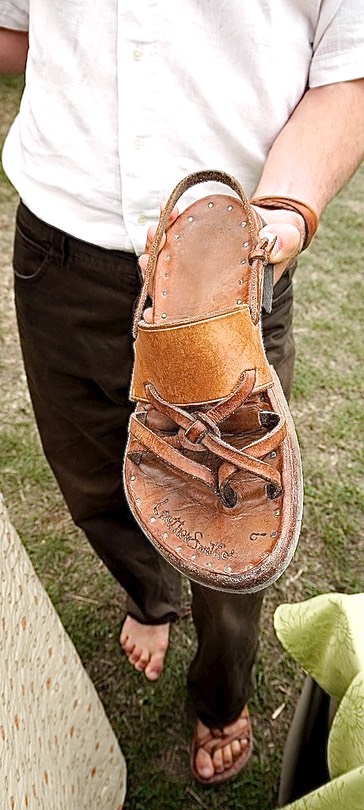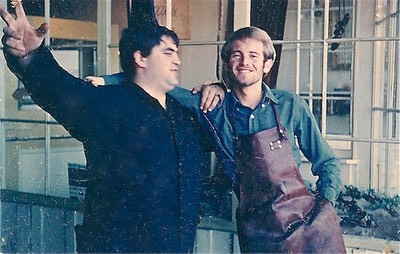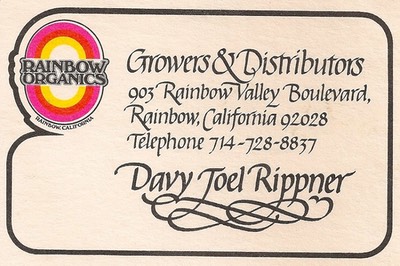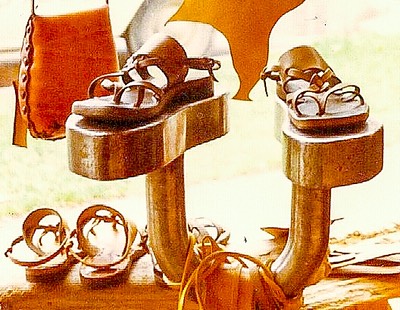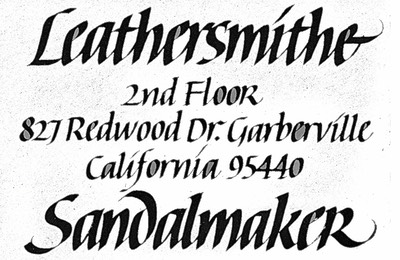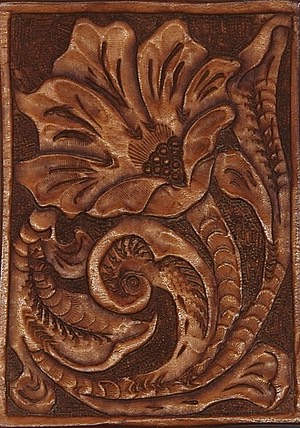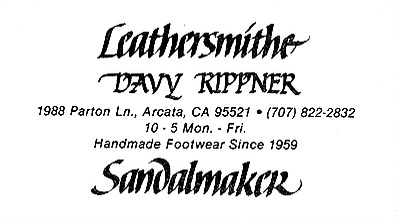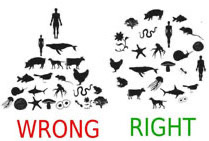Taking care of your sandals
Use a piece of coarse cloth (old denim, linen, or a horsehair shoe brush) to make a light lather with warm water in the saddle soap tin. Rub this foamy lather over and into every surface on the top and edges of your sandals, especially transition points. Straps should be saddle-soaped & pulled back & forth in their waxed channels, to loosen and clean them. Slots for the straps are tight but will loosen with age. The single long 3/8" strap will stretch, as will the broad arch strap, over the life of the sandals.
Tanneries use various substances to finish & stabilize leather. This is called “stuffing” the hides. That is what you will do with the lather you have created and it will render the cowhide malleable and flexible, so that it shapes to your feet & endures.
When you are done, use a brush or cloth to rub off surplus foam and allow the sandals to dry for 15 minutes. Then work dubbin sparingly into all the surfaces, edges and straps, until there isn't any residue. You can walk around in the sandals until they are dry (the quickest way to break in new sandals) or allow them to dry for a few hours before wearing them. While breaking in your sandals don't tighten your straps more than I do at your fitting or you will suffer needlessly. They will require a week or two of intermittent wear (walking in them) in order to fully break in. Some customers break them in the first day. You will know that they are broken-in when you don’t feel any discomfort at all.
Separation of the half-sole
The forward tip of the sandal is the most likely location for separation because it is the vulnerable leading edge. The cushy rubber I use for the half-sole & heel is a choice based partly on its absorptive qualities, part on comfort. Barge shoemakers cement permeates the rubber and can be depended upon to keep it attached to the equally-absorbent cowhide sole, but it sometimes lifts and should be dealt with at first notice.
I'm willing to have the sandals returned for me to do it, and I'll check them out for loose nails, strap-stretch, etc., at that time. That would be my first choice.
If, however, you want to do something immediately and continue wearing them without fear of further separation, you have a couple choices:
Purchase a small tube of contact cement and follow my instructions for bonding the separation in the tutorial half-way down, under Cementing Insole to Outer Sole.
Another option is to purchase a tube of Shoe Goo adhesive. (Home Depot, 3.7 oz for $11 Cdn). Use a toothpick to apply into the separation and clamp it together or put a weight on it while it sets up. Trim extra off afterward with a razor blade or sharp knife. This stuff is magical and I always have some on-hand for many kinds of repairs.
If you choose to make your own repairs, you can later bring or mail them to me and I'll make sure they are put into tip-top condition. The contact cement or Shoe Goo you use won't prevent me from doing my own repair, but will allow you to continue wearing them until you can get them back to my shoppe.
If it looks like you are prone to clipping the front on stairs or rocks, etc., I may put a clincher nail into the toe area from underneath, but am reluctant to do so. I'll decide when I see them.
Because I traveled extensively in my youth, I can imagine you in your sandals with a half-sole beginning to separate, or needing a replacement strap or a clincher nail, far from my workshoppe. I've designed and made them using traditional methods and out of traditional materials. In so doing I think you are safe having them repaired or the narrow strap replaced far from home if you can find someone who understands the design and construction. This may be more difficult than you would expect, now that shoemaking has become so automated. Best to return them (or a broken strap) to me, when this is possible. I'll keep them in righteous condition at no cost, and charge a fair price to replace half-soles or heels, when necessary.
Replacement of half-soles and heels
I offer cushy Soletec Soleflex (manu-facturer and product names) on new sandals because it is great for comfort (pea-gravel and sharp rocks deform the rubber instead of your feet) and has good traction, even when it is worn-down. It also is light and absorbent enough to allow the Barge shoe-makers contact cement or Renia Colle de Cologne to form an excellent bond.
Before & after refurbishing and sole & heel replacements:






I charge $55 to replace half-soles with Soleflex rubber and $45 for the heels. If your soles are wearing thin, you may want to replace both. If the heels need just a wedge of rubber or leather to build them up as in this photo, the charge is $30.
You may be able to find someplace nearby to have them resoled. They will have the machinery to do it quickly; I have to do it all by hand. Just be certain that if someone else repairs them they don't use nails or sew them, or your guarantee may not be honored. I use Barge or Renia Colle de Cologne shoemakers cement so that the structure of the sandals isn't compromised by quicker, more destructive repair methods.
If you decide to mail them to me for repair there will be a few-day turnaround, perhaps a week during my busy summer season. Don't forget to include your return address. Add $25 for postage in Canada, $35 for the USA.
My mailing address:
Davy Rippner 9886 Castle Road Pender Island
V0N 2M3 British Columbia Canada
<<If your sandals have worn through to the leather it is wise not to abrade the soles further: the midsoles are the backbones of your sandals.>>

"I would like to thank you and your masterful work ... even 5 years since new and they feel better than they ever have! The repair is perfect and the soles feel great. No adjustment to the heel strap necessary.
I get many compliments on these sandals and I always tell your story. It's impossible to fully translate to people how great they are since they fit my feet and my feet only, but I do my best.
I'll continue to love these sandals and wear them until they fall off my feet. I only wonder what the future holds when you will want inevitably to retire and I won't know where to go!
Every penny spent on the purchase and the subsequent repairs has been money well-spent and I'm glad to be able to support your business.” MM 6/2021
Begun June 23, 2017
